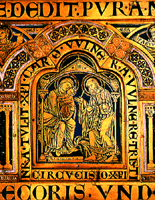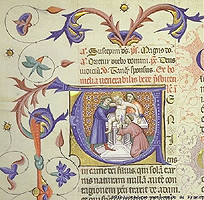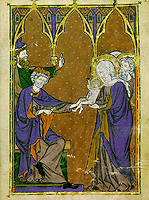 |
 |
Circumcision (Brit Milah)

Scriptural Basis:
Then God said to Abraham: "And you shall keep my covenant, you and your descendants after you throughout their generation. This is my covenant. . . Every male of you family shall be circumcised. You shall be circumcised in the flesh of your foreskins, and it shall be for a sign of the covenant between me and you. . . It shall be my covenant in your flesh, as an ever-lasting covenant. Any male who is not circumcised in the flesh of his foreskin shall be cut off from his people; he has broken my covenant. (Genesis 17)
On the eighth day of Isaac's life, Abraham obeyed the Lord and circumcised his son, Isaac. Ever since that moment, circumcision has been an important and essential part of Jewish men's lives. Circumcision is relevant to our topic as it is clearly a gendered act, a source of power, and deals directly with blood.
The Covenant:
"The LORD did not make this covenant with our fathers, but with us, the ones here today, all of us, the living" (Joshua 5)
Judaism is understood in terms of a covenental relationship:
1.YHVH (God) will be a god to Abraham and his descendants.
2 Abraham and his descendants will be a devoutly loyal people to God.
3. Circumcision will be the mark of this covenant.
The Rite:
From Judaism by Michael Fishbane
When a boy is born, a circumcision rite called a brit ("covenant," short for brit milah, "covenant of circumcision") can be expected eight days later. This ceremony, of great antiquity, confirms the transition of the infant from being a child of Adam, as it were, to a member of the Jewish people. Thus the boy enters the "covenant of Abraham." The minor operation is delegated by the father to a ritually trained surgeon, called mohel. The mohel receives the child after he has been passed among the relatives, beginning with the mother (in a separate room; she is customarily secluded at this time). Just before the boy is given to the godfather (called sandek) to hold while the operation is performed according to the ancient procedure, the mohel temporarily places the child on a "chair of Elijah" --symbolic of the hopes of redemption. After the actual circumcision, the child is handed to the father (or an honored guest) while the mohel recites blessings in praise of God and for the welfare of the child. It is then that the boy's name is announced. The name (e.g., David son of Abraham) will be how the boy will be "called up" when he is honored to bless the Torah in later years; and this name will be marked upon his tombstone at death. Already from antiquity some Jews have had double names, a Hebrew name and a related vernacular name (e.g., in Hellenistic times one might be Jonathan or Matthew and Theodore, names all meaning "gift of God") or names that could function in both the ritual and secular communities. Among Ashkenazi Jews, it is customary to name the boy after a deceased relative; Sephardis, however do not adhere to this practice. A joyous moment in the circumcision ceremony is when the entire assembly exclaims: "Just as he has entered the covenant, so may he enter [the study of] Torah, the wedding canopy, and good deeds." Thus a life cycled is outlined which all the adults confirm through their own lives.
Rabbinic Judaism from the Oral Torah:
The Mishnah Teaches (Nedarim 31b):
Rabbi Yehoshua said: "Great is the mitzvah of milah for Moses was not given even
an hour to delay it."
Rabbi Yehoshua ben Korcha said: "Great is the mitzvah of milah for all the good
deeds of Moses did not protect him when he delayed the milah (of his son Eliezer),
as it says (Exodus, 4:24): ‘And G-d encountered him and sought to put him to
death.’"
And Rabbi said: "Great is the mitzvah of milah because despite all of our
forefather Abraham’s good deeds, he was still not called a complete person until
he performed milah upon himself, as it says, only after his circumcision: ‘Walk
before Me and be complete.’"
from:Advocating Circumcision Today
The Gendered Nature of Circumcision:
 |
Judaism is a gendered religion. There are gendered roles throughout it. It is perhaps beyond any equal understanding of the division of the sexes in Judaism that the mark of the covenant rests squarely within the male domain. In Orthodox Judaism, circumcision is required to have access to the Torah. Being circumcised means carrying the mark of the covenant. Can one interpret this to mean that the covenant is continued through the men of the religion? Can one interpret this to demonstrate an inextricable sexism rooted deeply in the tradition of the religion? Can one go so far as to see as this evidence that in fact women are not engaged in the covenant? Perhaps, circumcision is evidence of the deeply rooted patriarchal nature of Judaism. |
From The Other Half: Women in the Jewish Tradition by Paula Hyman:
It is this traditional sex-role differentiation which is the central point of the feminist critique of Judaism, as of all other patriarchal cultures.
In patriarchal cultures virtually all social roles and most character traits are ascribed according to sex, with the positions of highest status and the most highly prized characteristics-- such as intelligence, initiative, emotional strength-- reserved for men. While men are allowed to define themselves through a wide spectrum of activity in the world, women are defined in sociobiological terms as wife and mother and relegated almost exclusively to the home and family life. The only qualities considered 'feminine' (and hence approved in women) are those which are useful in the serving, nurturing, and homemaking roles which are the women's preserve. One need not assume a male conspiracy to explain this social configuration. Obviously biological factors, chiefly the exigencies of childbearing, were critical. However, the biological underpinnings of patriarchal culture have been eroded-- childbearing, after all, occupies relatively little of modern woman's time-- and the role differentiation which they generated serves only to perpetuate inequality and to deny freedom of choice to men and women alike.
The position of women in Judaism rests upon this patriarchal sex-role differentiation and the concomitant disparagement of women. Thus, the halakhah exempts women from all postive time-bound mitzvot because of the nature of their family obligations, (though these may be shared with husbands or demand no more time than male occupational responsibilities). Since they are not halakhically required to participate in communal prayer three times a day, women cannot, in traditional Judaism, be counted in a minyan nor, as representative of the community, lead a service. Choosing to perform mitzvot does not raise one to the halakhic status of those obliged to do so.
Circumcision as a Sacrifice:
One must assess the value of the foreskin, because a sacrifice is only a sacrifice if that which is lost has some value. The value of the foreskin is solely that God has mandated that it be removed from all of his people. God has no other purpose for it. Therefore, circumcision is not a sacrifice. Sacrifices include things whose loss is counted. The loss associated with circumcision make it appear to be a sacrifice, but it is a mark of a covenant, not a sacrifice.
For a further discussion of sacrifice in Judaism click here
Blood in Circumcision:
And it came to pass by the way in the inn, that the Lord met him, and sought to kill him. Then Zipporah took a sharp stone, and cut off the foreskin of her son, and cast it at his feet, and said, 'Surely a bloody husband art thou to me. . . because of the circumcision. Exodus 4:25
 |
The presence of blood in this ritual is very important. The blood caused by the operation is considered holy blood. Blood is a symbol of life. In circumcision, the blood symbolizes the beginning of a Jewish life. In Orthodox and Conservative Judaism, male converts who have already been circumcised are require to participate in a Bris where a drop of blood is pricked from their penis, symbolizing their acceptance of the covenant. In Judaism, blood is often seen as polluting. Blood is carefully removed from meat before eating and menstruating women refrain from sex for seven days. These two instances are examples of blood, representing life, being separated from instances of death, or the loss of a potential life. In Circumcision, no such separation is necessary as the ritual is wholly engaged in life. |
Power in Circumcision:
Circumcision is a source of power in Judaism. In Orthodox Judaism, the ability to interpret the Torah is only available if a person is circumcised. It can be argued that the foundation of power in Judaism is in being male, as there is no such thing as a non-circumcised male. Circumcision is a prerequisite of being a Jewish man. However, the power of circumcision can not be denied. For a Jewish man, the rite of circumcision is perhaps second only in importance to birth. Men are not born into Judaism, they are circumcised into it.
A Mohel's Tools:
Click on image to enlarge.
The tools of a Mohel have changed little over several centuries. The surgery is very safe and simple and there is not, nor has there been, any untoward risk or danger involved with circumcision.
Links:
CIRP: Circumcision Information and Resource Pages
Kenyon College Web Site on Medical Aspects of Circumcision
For a site describing a baby naming ceremony for a girl click here